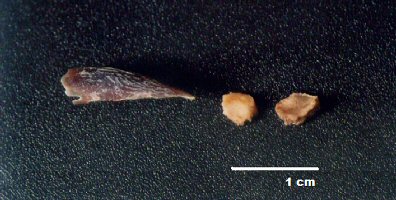|
IUCN/SCC Otter Specialist Group Bulletin
©IUCN/SCC Otter Specialist Group
Volume 26 Issue 2 Pages 65 -
131 (October 2009)
Citation: Quintela, F.M. and Gattii,
A. (2009). Armadillo
(Cingulata: Dasypodidae) in the Diet Of the Neotropical Otter
Lontra longicaudis in Southern Brazil . IUCN
Otter Spec. Group Bull. 26 (2): 78 – 81
Previous | Contents | Next
Armadillo
(Cingulata: Dasypodidae) in the Diet Of the Neotropical Otter
Lontra longicaudis in Southern Brazil
Fernando Marques Quintela1 and
Andressa Gatti2,
1Programa
de Pós-graduação em Biologia de Ambientes
Aquáticos Continentais, Instituto de Biologia, Universidade
Federal do Rio Grande, Caixa Postal 474, CEP 96201-900, Rio
Grande, RS, Brasil E-mail:boiruna@yahoo.com.br
1Programa de Pós-Graduação
em Biologia Animal, Universidade Federal do Espírito Santo,
Av. Marechal Campos, 1468 – Maruípe, Vitória,
ES, Brasil |
|
 
|
Abstract: Claws,
hairs and osteoderms of armadillo (Cingulata: Dasypodidae) were
found in a scat of a neotropical otter (Lontra longicaudis)
in an edge of a pluvial channel near a peat forest in the southern
Coastal Plain of Rio Grande do Sul state, southern Brazil. Due
to the absence of carrion-eating invertebrates in the sample,
it is suggested that the armadillo was actively preyed upon by
the otter. This is the first record of armadillo in the diet
of Lontra longicaudis. |
| Keywords: claws, cingulate, food habits,
osteoderms, predation, scat. |
| Française | Español |
Português |
The neotropical otter Lontra longicaudis Olfers, 1818 is
a semi-aquatic mustelid, distributed from northeastern Mexico to south
of Uruguay, Paraguay and across the northern part of Argentina to Buenos
Aires Province (Larivière, 1999). Investigations into the feeding
habits of L. longicaudis indicate a predominant piscivorous-cancrivorous
diet (Helder-José and Andrade, 1997; Pardini,
1998; Colares
and Waldemarin, 2000; Quadros and Monteiro-Filho
2001; Alarcon and
Simões-Lopes, 2004; Kasper et al.,
2004, 2008; Passamani
and Camargo, 2005; Quintela et al., 2008). Most of these studies have also
reported the occurrence of mammalian items such as rodents, didelphid
marsupials and other unidentified taxa in the fecal samples. In addition,
Quintela et al. (2008) identified the mephitid Conepatus chinga in
the feeding remains of a Neotropical otter from a coastal stream in
southern Brazilian restinga. Therefore, despite the low frequency,
mammals are a normal constituent of the diet of L. longicaudis.
In this paper we report the occurrence of armadillo (Cingulata: Dasypodidae)
in the diet of the neotropical otter in southern Brazil. Claws, osteoderms
and hairs of armadillo (Figure 1) were identified in one scat sample
collected on August 12th, 2008 in an edge of a pluvial channel near
a peat forest in Rio Grande city, southern Coastal Plain of Rio Grande
do Sul State (32°07’42”S – 52°09’13”W),
Brazil. Vegetation in the area is mainly composed by the arboreal Erythrina
crista-galli and the herbaceous Scirpus giganteus, Eryngium
pandanifolium, Bromelia antiacantha and Juncus sp.
Other items identified in the scat were scales of Mugil platanus (Perciformes:
Mugilidae), an abundant marine-estuarine fish in Patos Lagoon estuary
(Fischer et al., 2004). This was the only scat sample containing armadillo
remains in a total of 54 collected along the pluvial channel from November
2007 to August 2008. It was not possible to identify the armadillo
species in the sample. Two species (Dasypus novemcinctus Linnaeus,
1758 and D. hybridus Desmarest, 1804) are found in and around
the study area, being D. novemcinctus commonly trapped and
recorded through footprints in the edges of pluvial channels and coastal
streams. No carrion-eating invertebrates were found in the scat sample,
suggesting that the otter may have captured the armadillo alive.
 |
| Figure
1. Claw and osteoderms of armadillo (Cingulata: Dasypodidae)
found in Lontra longicaudis scat in southern Brazil.
Photo: Fernando M. Quintela. . (click for larger version) |
This is the first record of armadillo in the diet of Lontra longicaudis.
Other larger-sized mammals were recorded in the diet of L. longicaudis in
southern Brazil, such as the coypu Myocastor coypus (Colares
and Waldemarin, 2000) and the capybara Hydrochoerus hydrochaeris (Colares
and Waldemarin, 2000; Quintela et al., 2008). However, small rodents
represent the most common mammalian item found in the majority of investigations
concerning the feeding habits of the neotropical otter (e.g. Helder-José and
Andrade, 1997; Pardini, 1998; Alarcon
and Simões-Lopes, 2004;
Kasper et al., 2004, 2008; Quintela
et al., 2008). Armadillos have
been recorded in the diet of other carnivore species such as crab-eating
fox Cerdocyon thous (Rocha et al., 2004), hoary fox Lycalopex
vetulus (Jácomo et al. 2004), maned wolf Chrysocyon
brachyurus (Jácomo et al., 2004; Rodrigues
et al., 2007;
Bueno and Motta-Junior, 2009), crab-eating raccoon Procyon cancrivorus (Gatti
et al., 2006), and even free-ranging domestic cats Felis
catus and dogs Canis familiaris (Campos
et al., 2007).
The present account suggests Lontra longicaudis is a predator
of cingulates in the Campos Sulinos biome, and contributes to the
further understanding of the trophic ecology of the region's mammalian
fauna.
REFERENCES
Alarcon, G.G., Simões-Lopes,
P.C. (2004) The Neotropical otter Lontra
longicaudis feeding habits in a marine coastal area, southern
Brazil. IUCN Otter Spec. Group Bull. 21:
24-30.
Bueno, A.A., Motta-Junior, J.C. (2009) Feeding habits
of the maned wolf, Chrysocyon brachyurus (Carnivora: Canidae)
in southeast Brazil. Stud. Neotrop. Fauna Environm. 44:
67-75.
Campos, C.B., Esteves, C.F., Ferraz, K.M.P.M.B., Crawshaw Jr.,
P.G., Verdade, L.M. (2007) Diet of free-ranging cats and dogs
in a suburban and rural environment, south-eastern Brazil. J. Zool. 273:
14-20.
Colares, E.P., Waldemarin, H.F. (2000) Feeding
of the neotropical river otter (Lontra longicaudis) in a coastal
region of the Rio Grande do Sul State, Southern Brazil. IUCN Otter
Spec. Group Bull. 17: 6-13.
Fischer, L.G., Pereira, L.E.D., Vieira, J.P. (2004) Peixes
estuarinos e costeiros: série biodiversidade do Atlântico
Sudoeste, vol. 01. Ecoscientia, Rio Grande.
Gatti, A., Bianchi, R., Rosa, C.R.X., Mendes, S.L. (2006) Diet
of two sympatric carnivores, Cerdocyon thous and Procyon
cancrivorus, in a restinga area of Espirito Santo State, Brazil. J.
Trop. Ecol. 22: 227-230.
Helder-José, De Andrade, H.K. (1997) Food and
feeding habits of neotropical river otter Lontra longicaudis (Carnivora,
Mustelidae). Mammalia 61: 193-203.
Jácomo, A.T.A., Silveira, L., Diniz-Filho, J.A.F. (2004) Niche
separation between the maned wolf (Chrysocyon brachyurus),
the crab-eating fox (Dusicyon thous) and the hoary fox (Dusicyon
vetulus) in central Brazil. J. Zool. 262:
99-106.
Kasper, K.B., Feldens, M.J., Salvi, J., Grillo, H.C.J. (2004) Estudo
Preliminar sobre a ecologia de Lontra longicaudis no Vale
do Taquari, Sul do Brasil. Rev. Bras. Zool. 21:
65-72.
Kasper, C.B., Bastazini, V.A.G., Salvi, J., Grillo, H.C.Z. (2008) Trophic
ecology and the use of shelters and latrines by the Neotropical otter
(Lontra longicaudis) in the Taquari Valley, Southern Brazil. Iheringia,
Ser. Zool. 98: 469-474.
Larivière, S. (1999) Lontra longicaudis. Mammal.
Species 609: 1-5.
Pardini, R. (1998) Feeding
ecology of the neotropical river otter Lontra longicaudis in
an Atlantic Forest stream, south-eastern Brazil. J. Zool. 245:
385-391.
Passamani, M., Camargo, S.L. (1995) Diet
of the river otter Lutra longicaudis in Furnas Reservoir,
south-eastern Brazil. IUCN Otter Spec. Group Bull. 12:
32-34.
Quadros, J., Monteiro-Filho,
E.L.A. (2001) Diet of the neotropical otter, Lutra
longicaudis, in an Atlantic Forest area, Santa Catarina State,
Brazil. Stud. Neotrop. Fauna Environm. 36(1):
15-21.
Quintela, F.M., Porciuncula,
R.A., Colares, E.P. (2008) Dieta de Lontra
longicaudis (Olfers) (Carnivora, Mustelidae) em um arroio costeiro
da região sul do Estado do Rio Grande do Sul, Brasil. Neotrop.
Biol. Cons. 3: 119-125.
Rocha, V.J., Reis, N.R., Sekiama, M.L. (2004) Dieta
e dispersão de sementes por Cerdocyon thous (Linnaeus)
(Carnivora, Canidae), em um fragmento florestal no Paraná, Brasil. Rev.
Bras. Zool. 21: 65-72.
Rodrigues F.H.G., Hass A., Lacerda A.C.R., Grando L.R.C.S.,
Bagno M.A., Bezerra A.M.R., Silva W.R. (2007) Feeding
habits of the maned wolf (Chrysocyon brachyurus) in the Brazilian
Cerrado. Mast. Neotrop. 14: 37-51.
Résumé : Le tatou
(Cingulata: Dasypodidae) dans la diète de la loutre neotropical
(Lontra longicaudis) au su du Brésil
Onglis, poils et osteodermes du tatou ont été trovés
dans un énchantillon d’excrément de la loutre
néotropicale (Lontra longicaudis), au bord du canal
pluvial proche d’une fôret paludéenne, dans la
région sud de la Plaine Côtière de l´État
du Rio Grande do Sul, au sud du Brésil. Le tatou a été probablement
capture, puisqu’aucune carcasse d’invertébré en
décomposition n’a été trouvé dans
l’échantillon fécal. C’est la première
fois que l’on recense des restes de tatou dans la diète
de la Lontra longicaudis.
Revenez au dessus
Resumen: Armadillo (Cingulata:
Dasypodidae) en la dieta de la nutria neotropical (Lontra longicaudis)
en el sur de Brasil
Uñas, pelos y osteodermis de armadillo (Cingulata: Dasypodidae)
fueron encontrados en una muestra de heces de la nutria neotropical
(Lontra longicaudis) en la margen de un canal pluvial cerca
a una vegetación palustre en la región sur de la Planicie
Costera del Estado de Rio Grande do Sul, sur de Brasil. Es probable
que el armadillo depredado ha sido activamente capturado, una vez
que invertebrados descompositores de armazones no fueron encontrados
en la muestra fecal. Este es el primer registro de armadillo
en la dieta de la Lontra longicaudis.
Vuelva a la tapa
Resumo: Tatu (Cingulata:
Dasypodidae) na dieta da lontra neotropical (Lontra
longicaudis) no
sul do Brasil
Unhas, pêlos e osteodermes de tatu (Cingulata:
Dasypodidae) foram encontrados em uma amostra de fezes da lontra neotropical
(Lontra longicaudis) na margem de um canal pluvial próximo a
uma mata palustre na região sul da Planície costeira
do Estado do Rio Grande do Sul, sul do Brasil. Provavelmente o tatu
predado foi ativamente capturado, uma vez que invertebrados decompositores
de carcaças
não foram encontrados na amostra fecal. Este é o primeiro
registro de tatu na dieta de Lontra longicaudis.
Retorne à parte superior
Previous | Contents | Next
|



